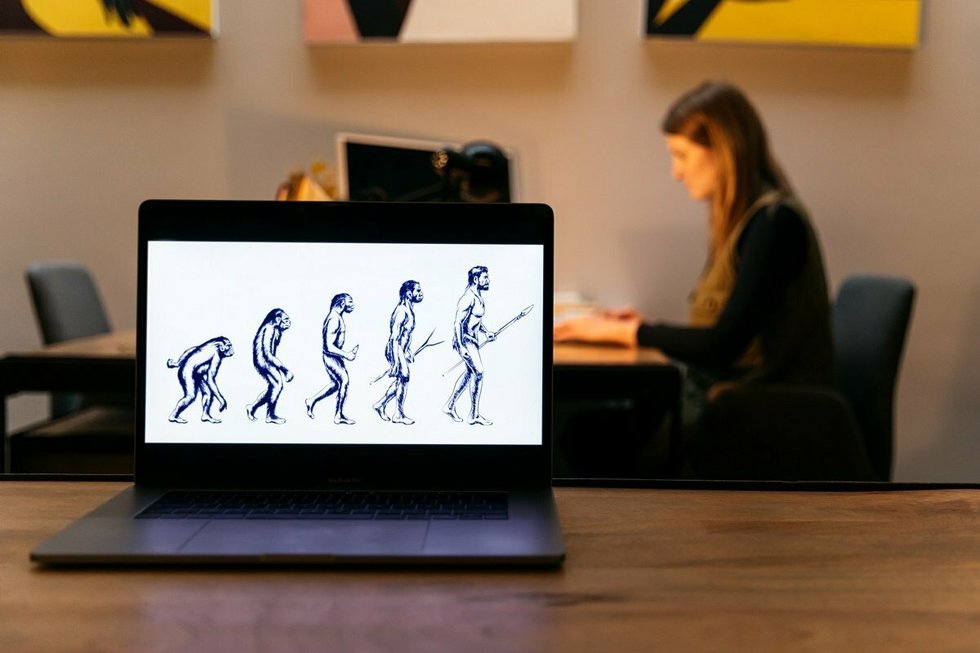Gender inequality at work: what we can learn from our prehistoric ancestors
Jun 07, 2021
7 mins


In the past ten years or so, the study of history has become increasingly important culturally and politically in promoting gender equality, both in the context of the workplace and beyond. Traditionally, however, males have dominated the field of history, which is too often focused on the achievements of men. Take the 19th century’s Great Men theory of leadership, for example. As Scottish historian Thomas Carlyle wrote, “The history of the world is but the biography of great men.” But times have changed. Schools no longer teach history solely by recalling the creative genius, inventiveness, political courage, and military exploits of men. Awareness of cognitive bias has increased and we now know how role models and stories shape children’s imaginations and influence their career choices. Similarly, prehistory has always influenced workplace gender roles, in accordance with the hunter-gatherer model. Although archaeology could have left room for diverse and tentative interpretations, 19th-century thinkers simply transposed their contemporary gendered division of labor onto prehistory. They used their incomplete understanding of Palaeolithic human societies to demonstrate that the gender roles of their own time were “natural”. However, prehistoric gender clichés have mostly been debunked. And perpetuating them merely maintains the prejudices that continue to fuel gender inequality in the modern workplace.
Marylène Patou-Mathis is a prehistorian and director of research at the CNRS (French National Centre for Scientific Research). In her 2020 book L’homme préhistorique est aussi une femme (Prehistoric Man is also a Woman), she said: “No, prehistoric women didn’t spend all their time sweeping the cave and looking after the children while waiting for the men to return from the hunt. The idea of reducing them to the role of prehistoric housewives is wrong. They also pursued large mammals, made tools and ornaments, built habitats, and explored forms of symbolic expression. There is no archaeological evidence that certain activities were forbidden to women in the earliest societies, nor that they were considered inferior and subordinate to men.”
In examining the gendered accounts of history and prehistory, Patou-Mathis provides new perspectives on the modern workplace, its current issues, and possible futures. How can we end the gendered division of labor if we still associate certain tasks with women and others with men? How can history help us to envision the future differently, open new career paths, and promote equality? The pandemic and the resulting “secession” caused us to take a step back in terms of equality. What if looking back at prehistory in a different way could help move things forward again?
This is where the future and prehistory connect: we must stop projecting biases from modern society onto our views of prehistoric humanity.
Although Patou-Mathis’s books have not been translated into English, this one is strongly recommended for any French speakers interested in gender inequalities at work. Specifically, it offers insights into how these inequalities are maintained by traditional narratives, how businesses envision future models, and reveals the cultural biases that keep those models trapped in the past.
“Until the end of the 19th century, artistic and literary production, with rare exceptions, built up an image of prehistoric men as violent. (…) The approach of the first prehistorians and the image they bequeathed of prehistoric humans revolved around two major biases: a primordial violence and a progressive and linear evolution of human history.” Marylène Patou-Mathis in L’homme Préhistorique est aussi une Femme.
Gender essentialism and the subordination of women
Gender essentialism is the belief that a person, thing, or trait is inherently and permanently masculine or feminine. Many of us have seen how some managers prefer to recruit women for positions that require “listening skills” and “empathy”, and men for positions where a certain “charisma”, “drive” and “vision” are expected. Over recent decades, many businesses have become more gender-diverse, with an increasing number of female board members. Some roles, however, just can’t shake the cliches of gender and many occupations remain gender-segregated. Almost 80% of care workers and almost 87% of NHS nurses and health visitors are women. Society seems stuck in a rut of seeing the caring professions as solely the domain of women.
At the same time, women remain very much in the minority when it comes to highly paid positions of authority; this is true even in sectors hiring increasing numbers of women. For example, while there are almost as many female doctors as male, specialists and surgeons still tend to be male. The same applies in the field of higher education, where men dominate the most prestigious positions.
More recently, the pandemic showed the links between gender inequalities in the workplace and in the home. The majority of unpaid domestic work, such as childcare, cleaning, and preparing meals, falls on females. Women have been more likely to have a vastly different experience of working from home than men and to feel pressured to accept part-time hours or short-time working—with reduced pay, of course.
“As with anthropology, people, primarily women, are speaking out against androcentrism [the practice of placing a male point of view at the center of one’s worldview] in archaeology. (…) Research into this bias has revealed the mechanisms that dominate our interpretations of archaeological data. From the role of women and their status and behaviors to archaeological material and prehistoric art, everything is seen through the prism of the male gaze and analyzed by resorting to essentialism.”
Perpetuating the gendered division of labor, with women remaining held back by inequalities in the workplace and at home, can be explained by cognitive biases, conscious or unconscious discriminatory practices, or specific policies. But they are all rooted in essentialized categories of “feminine” and “masculine” qualities prevalent in the 19th century, when science attempted to justify the inferiority of women.
Narratives about prehistory played a central role in this gender essentialism. If Palaeolithic women were passive cave-dwellers while men were violent hunters, then these differences must be “natural”. Patou-Mathis explains how prehistory emerged as a scientific discipline during this period: “A few grams of the brainless and a smaller skull; soft flesh and an intelligence exposed to the vagaries of menstruation; always complaining and potentially hysterical—since Hippocrates, such gender stereotypes have dominated the male-dominated field of medicine, which methodically justified itself to perpetuate and consolidate the domination of one sex over the other.
“In anthropology, sexist ideology persisted until the mid-20th century. It was denounced in the 1980s by several American anthropologists who questioned the androcentrism of anthropological thought and challenged the legitimacy of male domination based on a naturalistic view of women.”
Prehistoric women were not how you think they were
While clichés about the lives of prehistoric men and women persist to this day, the science supporting them has been debunked. In the 19th and early 20th centuries, interpretations of prehistoric artifacts were often based on the biased viewpoints of the contemporary era. Today, the field is equipped with new archaeological and prehistorical perspectives, involving scientists’ different backgrounds and new techniques such as DNA analysis of skeletal remains. It’s become increasingly apparent that we have much to learn about prehistoric women.
Intelligent and engaging, Patou-Mathis’s book turns to the newest research and discoveries in dismantling many preconceived ideas about prehistoric women. Here are seven ways to see our ancestors in a new light:
1. The hunter-gatherer gender binary is but a “normative fairy tale”
“There is no archaeological evidence that clearly shows a division of labor during hunting.” There are even lesions on bones, thought to be female, that indicates repeated hunting activities; for example, lesions on an elbow may be a sign of repeated spear throwing. “Given the data, we cannot exclude the possibility that women were involved at every stage of the hunt in certain European Palaeolithic societies, with activities such as locating and decoding animal tracks, developing hunting strategies, and even firing weapons.”
2. There is no evidence to suggest women weren’t toolmakers and inventors
Many classical stories, such as the myth of Prometheus, solely associate men with fire-building and tool-making. In our collective imagination, inventors and innovators are almost always men. And the earliest prehistorians were no different; for them, hard materials such as stone, bone, wood, and metal must have been the purview of men alone. Now disproved, such assumptions show more about the time they were made—and just because something was true in the 19th century does not mean that it was true 50,000 years ago!
3. Prehistoric women were not fragile creatures whose successive pregnancies restricted their mobility and whose lack of physical strength prevented them from doing certain tasks
The sex has not been determined of more than half of the prehistoric skeletons found. But thanks to recent scientific advances, some skeletons once thought to be male have been found, in fact, to be female. What’s more, analysis shows that these women were muscular, athletic, sturdy, and very physical. From nomadic societies, these “tireless, muscular, and skillful walkers” made long journeys during seasonal migrations.
4. They were likely also artists who made cave paintings and figurines
It is commonly assumed that the prehistoric artists were men since women took care of the food in the cave. “For almost a century and a half, interpretations of Palaeolithic cave paintings and figurines were based on the presupposition that only men did them.” In fact, there is absolutely no evidence to support this claim. Moreover, many hand impressions on the walls near the paintings, which could have been a way of signing the work, have been identified as female.
5. Paleolithic carvings have long been seen from the perspective of the male gaze
Remember the so-called “Venus” carvings you learned about in school? The overwhelming majority of Palaeolithic figurines depict women and even pregnant women. In the past, prehistorians assumed they were made by men for men, as cult or erotic objects. But the shape could also represent what a pregnant woman sees looking down at her own body: a prominent belly, foreshortened legs, and no head. At a time when giving birth was fraught with danger, they may well have felt the need to create amulets for luck. From this perspective, many of these figurines could have been made by women for women.
6. Women likely played a key role in many religious rituals
One hypothesis posits that religious beliefs were the core motivation behind cave paintings. “There is no archaeological evidence to exclude women’s involvement in conducting ceremonies. Prehistorians no longer believe women were kept out of this mysterious world.” In fact, some of them may well have served as shamans.
7. Throughout history, women have fought in wars
“In the 19th century, patriarchal western society could not accept the existence of female warriors.” However, excavations and research since that time have shown that women were indeed warriors. It is now commonly believed that there were female Viking warriors, a facet of that history which has been popularized by recent TV series. And archaeology has shown that the Amazons, who most likely came from a region between modern-day Russia and Kazakhstan, were real.
Patou-Mathis breaks down many assumptions in her book, including the idea that prehistoric men were violent toward women. Once again, skeletal analysis has proved that this was not necessarily the case. The book highlights the importance of diverse perspectives in understanding data and information. Without diversity, gender essentialism leads to bias and blind spots.
This is where revisiting prehistory can have an impact on the workplace. In HR, for example, the essentialist vision that determines gender inequalities must be challenged. Companies need to promote role models that will inspire new career paths. In developing corporate strategy, we need to analyze the lessons of history better, so businesses can plan for a future that is culturally different from the present. My advice? Look to prehistory for inspiration.
Translated by Andrea Schwam
Photo: Welcome to the Jungle
Follow Welcome to the Jungle on Facebook, LinkedIn, and Instagram, and subscribe to our newsletter to get our latest articles every day!

More inspiration: Laetitia Vitaud
Future of work author and speaker

Age does matter, at work and in the White House
What we've learned from the 2024 presidential elections about aging at work.
Sep 09, 2024

Can companies avoid a brain drain as retirements surge?
Bye bye, Baby Boomers. Hello, knowledge exodus?
Jun 12, 2024

Workplace anxiety: Navigating the future of work in an anxious world
Anxiety has taken center stage in our modern world. How is it shaping the future of work? And most of all, what can we do about it?
May 20, 2024

Why recruiters should hire more ex-freelancers
While freelance and salaried work can seem worlds apart, they may have more in common than you think.
May 02, 2024

How women over 50 are reinventing their careers and the future of work
Women in their 20s struggle to be taken seriously, while middle-aged women battle discrimination... So how are women over 50 reinventing the wheel?
Apr 02, 2024
The newsletter that does the job
Want to keep up with the latest articles? Twice a week you can receive stories, jobs, and tips in your inbox.

Looking for your next job?
Over 200,000 people have found a job with Welcome to the Jungle.
Explore jobs